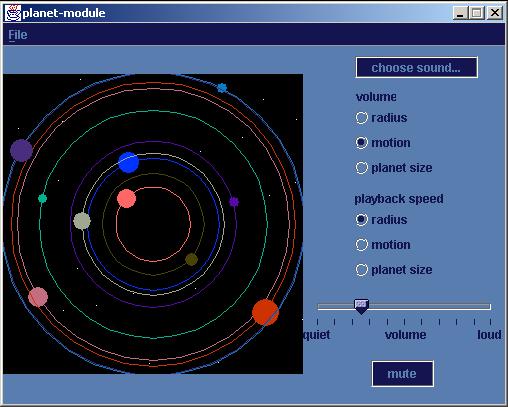
part of the JPMorgan Chase Kids Digital Movement and Sound Project
(c)2002 douglas irving repetto and Jason Freeman

planet-module turns your discs into a solar system!
Each disc becomes a planet, and each planet is drawn on the screen along with its orbit. As a disc moves closer or further away from the center of the solar system, the size (radius) of its orbit changes too.
Each planet also controls a layer of sound. The number of layers of sound is the same as the total number of planets. Each layer plays a looping sound, but the volume and playback speed of that layer vary according to characteristics of the planet — the size of the planet, the size of its orbit, or its direction of motion — which you choose.
change sound:
By default, planet-module uses an alien
"eep" sound. By clicking the "change sound" button,
you can replace the "eep" with any other sound you want. Many
sounds are included in the "Sounds" folder" for you to
choose from. You may also use your own sound files, but those files must
be mono, 16 bit, AIFF or WAV format, files.
volume radio buttons:
playback speed radio buttons:
Use these radio buttons to decide how planet-module sets the volume
and playback speed of each layer based on characteristics of each planet:
volume:
Use this slider to control the volume of all of the sounds.
mute:
Use this button to turn the sound off and on.
To get a sense of how planet-module works, try it out with only a single planet at first. Then add more planets once you get the hang of it.
planet-module can handle only a limited number of total planets at a time. The exact number varies depending on the speed of your computer; usually, 10 or 15 total planets is the maximum. If you hear clicks and pops in the sound, or if planet-module crashes, then you probably had too many total planets. If you are nearing the maximum number of planets, planet-module may give you a warning message, and it may start using only some of your discs as planets.